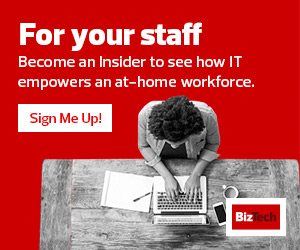BIZTECH: Where is the industry now in its digital transformation journey?
WARD: We’re about to release our latest “Managing Tech Change Report,” which details results of a survey we put out to the whole community. We need to be able to print that sad trombone sound: One of the findings is that only 10 percent of respondents said that all people on their team even know what the decision-making process is when it comes to technology. Well, if you don’t know what the process is, I don’t imagine the process is going smoothly and getting you to the best outcomes.
Here’s an example: There’s an organization that, pre-pandemic, provided mental health support services to the local population. Enter the pandemic. Like many organizations they said, “We’ll just move to Zoom.” After a year or so, they noticed they’re no longer serving only patients in Queens, N.Y. Now they have patients in Wisconsin and Colorado. They said, “That’s not our mission to serve those people, but it’s not our moral standing to no longer serve patients we’ve taken on.” So, they created a world where technology decisions are to some degree deciding their mission. Zoom isn’t the problem, but the application of the technology was made without a clear understanding of what it would mean to move that service online.
Where are we at two years in? I would characterize it as still a bit messy, trying to be intentional, but still managing the reactive-type decisions that were made before and continuing to see the biggest pulls on our missions that we’ve ever had. There’s an incredible community need that organizations want to meet, and they are still struggling to find that breathing space in their staff time and capacity, or in their budgets, to do that kind of intentional planning around technology.
BIZTECH: With the understanding that nonprofits vary in size and scope, do they generally have qualified technology leadership, or do they have a people challenge?
WARD: At NTEN, we typically refer to the “technology manager” and “technology-responsible staff person.” When you look at a technology-responsible staff member, it’s common that technology is just a part of someone’s job.
MORE FOR NONPROFITS: Explore the industry tech trends to watch in 2022.
What’s interesting is that our research shows there are nonprofits of every budget size at the leading edge when it comes to tech, and organizations of every budget size at the very back. It’s not just about how much money you have for technology; it’s about how you use it. We see organizations with very small budgets putting that money to work very well.
In our survey, we asked people what the biggest barriers are to technology change. The perception is always that money is the biggest barrier, but in reality, the biggest barrier is staff time. Over 80 percent said that was a barrier for them, and that’s across budget size. Change is hard and it takes time, especially for technology that undergirds the entire organization’s mission. It takes every single staff member learning that new system.
BIZTECH: When it comes to technology, what do you see nonprofits getting right?
WARD: The most promising examples are those of organizations inviting community members into the decision-making process, saying, “You’re the ones that are the participants in this service. What do you actually need?” Sometimes, the needs and priorities from the community aren't on the organization's roadmap. Prioritizing users means those tech investments will bring better outcomes.
BIZTECH: What are nonprofits getting wrong?
WARD: A lot of organizations deployed technology tools because they worked for individual teams or programs, but those things are isolated and they’re not working together. How do these folks, who have tried to make good decisions about how to get the tools they need for specific purposes, now figure out how to get those tools to talk to each other? What does that mean for trying to use data to improve what they do and for the experience of the community members interacting with them?
Click the banner below and receive exclusive hybrid work content when you register as an Insider.













